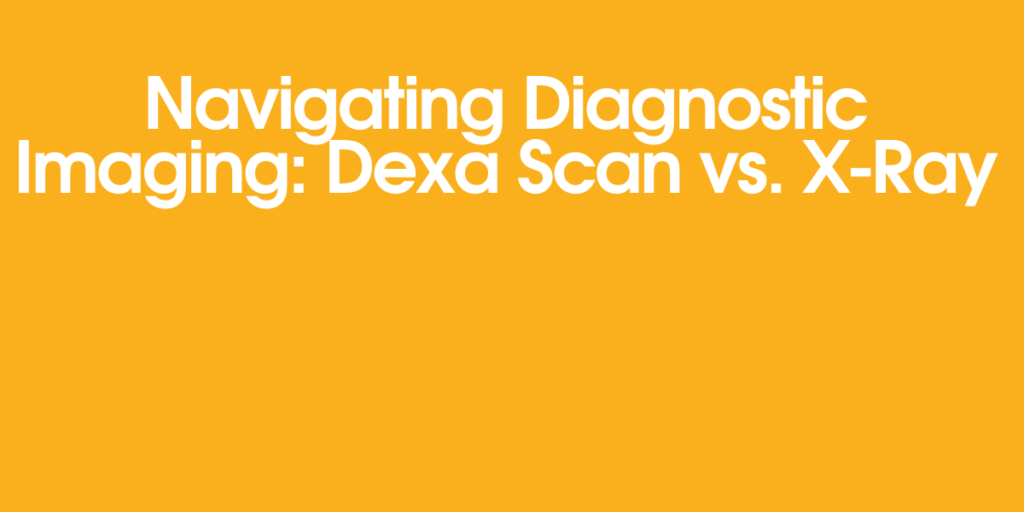Have you ever found yourself facing a dilemma when it comes to choosing the right imaging technique for your health needs? With a multitude of options available, it can be overwhelming to determine which one is best suited for your specific situation. In this blog, we’ll take a closer look at two commonly used imaging modalities—Dexa scans and X-rays—and explore how to navigate the decision-making process to ensure you’re choosing the right technique for your health needs.
Understanding Dexa Scans: Delving into Bone Health
Let’s kick things off with Dexa scans. These specialized imaging tests are primarily used to assess bone density and diagnose conditions like osteoporosis. Dexa Scan work by emitting low-dose X-rays to measure the density of bones in key areas of the body, such as the spine, hips, and wrists. By evaluating bone mineral density, Dexa scans help healthcare providers identify individuals at risk of fractures and osteoporosis-related complications. They are particularly useful for older adults, postmenopausal women, and individuals with risk factors for osteoporosis.
Exploring X-Rays: Peering into the Inner Workings
On the other hand, we have X-rays, the workhorses of diagnostic imaging. X-rays use electromagnetic radiation to produce detailed images of the body’s internal structures, including bones, organs, and tissues. These versatile scans are invaluable for detecting fractures, assessing joint health, and diagnosing conditions ranging from pneumonia to dental problems. With their ability to capture images in real time, X-rays provide immediate insights that guide treatment decisions and help healthcare providers deliver timely interventions.
Choosing the Right Imaging Technique
Now that we’ve shed light on Dexa scans and X-rays let’s discuss how to choose the right imaging technique for your health needs. The decision ultimately depends on several factors, including the purpose of the imaging test, the area of the body being evaluated, and the specific concerns or symptoms you’re experiencing. If you’re primarily concerned about bone health and osteoporosis, a Dexa scan may be the most appropriate choice. Conversely, if you’re experiencing symptoms such as pain, swelling, or injury, an X-ray may be necessary to assess the underlying cause.
Considerations for Specific Health Conditions
When deciding between Dexa scans and X-rays, it’s also important to consider any specific health conditions or risk factors you may have. For example, if you have a family history of osteoporosis or if you’ve recently experienced a fracture, a Dexa scan may be recommended to assess your bone density and evaluate your risk of future fractures. On the other hand, if you’ve sustained a sports injury or if you’re experiencing symptoms such as difficulty breathing or persistent cough, an X-ray may be necessary to investigate the underlying cause.
Consulting with Your Healthcare Provider
Ultimately, the best way to determine the most appropriate imaging technique for your health needs is to consult with your healthcare provider. They can evaluate your medical history, perform a physical examination, and recommend the most suitable imaging test based on your circumstances. Whether it’s a Dexa scan or an X-ray, your healthcare provider will ensure that you receive the highest quality care and the most accurate diagnosis possible.
Considering Additional Factors: Age and Radiation Exposure
In addition to understanding the differences between Dexa scans and X-rays, it’s essential to consider additional factors that may influence your decision-making process. Age plays a significant role in determining the appropriateness of certain imaging tests. For example, Dexa scans are commonly recommended for postmenopausal women and older adults due to their increased risk of osteoporosis. Similarly, X-rays may be more appropriate for individuals of all ages who present with acute injuries or symptoms requiring immediate evaluation.
Another consideration when choosing between Dexa scans and X-rays is the potential for radiation exposure. While both imaging techniques utilize low levels of radiation, Dexa scans typically involve less radiation than traditional X-rays. This feature makes Dexa scans a safer option for individuals who require regular monitoring of bone density or those who may be more sensitive to radiation exposure, such as pregnant women or young children. However, it’s essential to weigh the benefits of diagnostic imaging against the potential risks of radiation exposure and discuss any concerns with your healthcare provider.
Considering Proximity and Accessibility: Finding Imaging Centers Near You
In addition to understanding the differences between Dexa scans and X-rays and considering additional factors such as age, risk factors, and radiation exposure, it’s essential to prioritize proximity and accessibility when choosing an imaging centre. Convenience plays a significant role in ensuring timely access to diagnostic services, particularly for individuals with mobility limitations, transportation challenges, or busy schedules.
When researching imaging centres, please take into account their proximity to your home, workplace, or healthcare provider’s office. Look for “Dexa and X-ray near me” that is easily accessible via public transportation or within a reasonable driving distance. Many imaging centres offer flexible appointment scheduling and extended hours to accommodate diverse patient needs, making it easier to find a convenient time for your scan.
Moreover, consider the amenities and services offered by different imaging centres to enhance your overall experience. Look for facilities that provide ample parking, comfortable waiting areas, and friendly staff who prioritize patient comfort and satisfaction. Additionally, inquire about any special accommodations available for individuals with disabilities or specific medical needs to ensure a seamless and stress-free imaging experience.
Conclusion: Empowering Your Health Journey
In conclusion, Dexa scans and X-rays are invaluable tools in the diagnostic toolkit, each offering unique insights into your health. Whether you’re concerned about bone density, joint pain, or underlying medical conditions, choosing the right imaging technique is essential for accurate diagnosis and personalized care. So, don’t hesitate to discuss your health concerns with your healthcare provider and explore the options available to you. By taking an active role in your health journey, you can empower yourself to make informed decisions and prioritize your well-being.


More Stories
Why Third Party Manufacturing Is the Backbone of the Pharma Industry in 2025
Becoming a Pharmaceutical Distributor with Aenor Pharmaceuticals
Is Your Sedentary Lifestyle Destroying Your Hip?